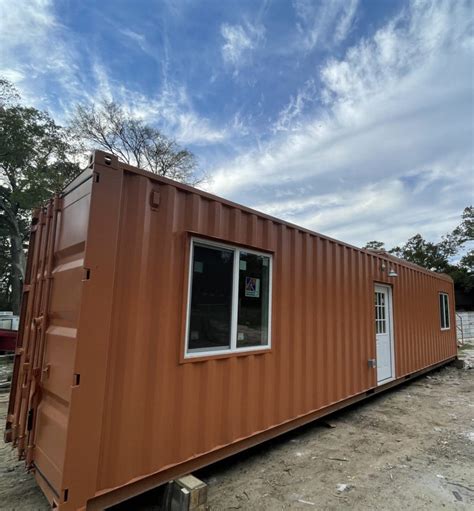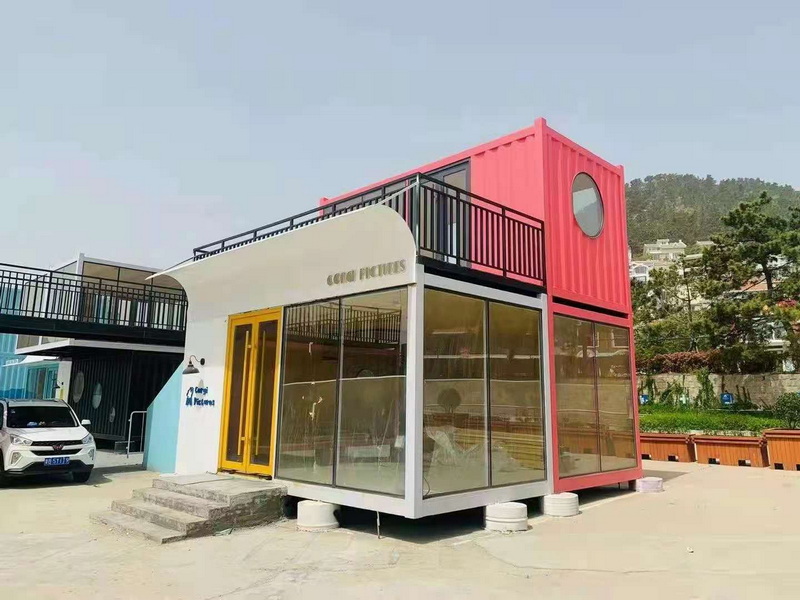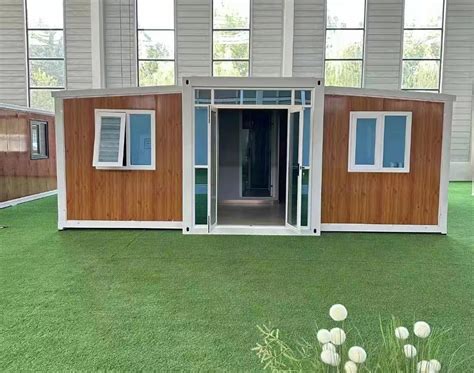Content Menu
● The Rise of Container Houses in Japan's Housing Market
● Leading Container House Manufacturers and Suppliers in Japan
>> 1. Karmod
>> 2. Sankyo Frontier
>> 3. Lida Group
>> 4. Wortley Design
>> 5. New House Japan
● Popular Container House Types and Configurations in Japan
● Innovations in Japanese Container House Design
● Recommended Multimedia Content to Enrich This Article
● Conclusion
● FAQ
>> 1. What makes container houses ideal for Japan's urban environment?
>> 2. How do Japanese container house manufacturers ensure earthquake safety?
>> 3. Can container houses incorporate traditional Japanese design elements?
>> 4. What sustainability benefits do container houses provide?
>> 5. Where can I purchase or lease container houses in Japan?
Japan's distinctive blend of cutting edge technology, long standing cultural traditions, and limited urban space has propelled container houses into a sought-after solution for modern housing and commercial applications. The country's rising demand for sustainable, efficient, and resilient living spaces has encouraged manufacturers and suppliers to innovate modular container designs that maximize functionality, safety, and aesthetic harmony with Japanese surroundings.This article offers a comprehensive exploration of the leading container house manufacturers and suppliers in Japan. It covers their key products, technical innovations, diverse applications, and how container homes meet Japan's unique environmental, regulatory, and cultural requirements.

The Rise of Container Houses in Japan's Housing Market
Japan faces distinctive challenges related to housing and construction: acute space scarcity due to high population density, vulnerability to frequent natural disasters (mainly earthquakes and typhoons), and robust environmental policies promoting sustainability. Container houses have consequently risen as an efficient and practical alternative to traditional building methods due to several advantages:
- Space Efficiency: Modular designs adapt well to constrained urban plots, allowing vertical stacking or sideways configurations that maximize usable area.
- Cost-Effectiveness: Factory-based production minimizes onsite labor, reducing construction time and expenses.
- Durability: The steel frames used in container houses provide excellent resistance to earthquakes and typhoons, critical for Japanese safety standards.
- Sustainability: Repurposing shipping containers and integrating green technologies align with Japan's environmental targets.
- Customizability: Designs range from minimalist Japanese interiors featuring shoji screens and tatami mats to upscale homes blending modern and traditional styles.
This unique combination makes container houses increasingly popular among urban dwellers, public agencies, commercial operators, and private homeowners.
Leading Container House Manufacturers and Suppliers in Japan
1. Karmod
Karmod is a distinguished international manufacturer whose modular container homes have successfully adapted to Japan's specific market needs. Renowned for flat-pack container cabins and fully customizable modular homes, Karmod emphasizes:
- Design flexibility aligned with Japanese tastes and regulations.
- Energy-efficient materials including thermal insulation and double-glazed windows.
- Integration of renewable energy such as solar power.
- Blending traditional Japanese design elements (like sliding shoji doors) with contemporary features.
- Factory precision ensuring rapid onsite assembly and strict quality assurance.
- Competitive pricing to increase accessibility across income brackets.
Karmod's modular container solutions serve a variety of purposes including residential houses, commercial offices, retail outlets, and temporary accommodations.
2. Sankyo Frontier
Established in 1969, Sankyo Frontier stands as Japan's leading modular building specialist, offering innovative container and prefabricated buildings for industrial, commercial, and residential users.
- Their container homes incorporate smart building technologies for enhanced earthquake resistance and energy efficiency.
- They maintain meticulous compliance with Japan's building codes related to seismic safety, fire standards, and insulation.
- Product offerings range from compact single-family homes to multi-unit commercial complexes.
- A nationwide network ensures rapid manufacturing and delivery capabilities.
With decades of expertise, Sankyo Frontier ranks among the most trusted manufacturers and suppliers for modular container buildings in Japan's domestic industry.
3. Lida Group
Though originally based in China, Lida Group has established a strong presence supplying welded and modified shipping container homes to Japan.
- Their steel-framed containers include premium insulation suited to Japanese climatic variations.
- Interiors are pre-equipped with plumbing, electrical wiring, and customizable decor packages.
- Versatility allows for residential, holiday home, office, cafe, and commercial applications.
- Strict adherence to Japanese fire and seismic standards ensures safe deployment.
- OEM services enable collaboration with Japanese importers and distributors.
Lida Group's blend of quality craftsmanship and international logistics makes them a prominent player among Japan's container house suppliers.
4. Wortley Design
Wortley Design, a boutique Japanese container house manufacturer, crafts high-end modular homes that merge Japanese minimalism with industrial aesthetics.
- Use of premium materials like reclaimed wood and brushed steel enhances interior warmth and character.
- Spacious, natural light-filled interiors connect residents with nature despite urban site constraints.
- Multi-container configurations include vertical stacking and adjacent placements for extended living or working space.
- Highly customizable offerings appeal to customers seeking stylish, sustainable, and unique homes.
Wortley Design epitomizes the fusion of Japanese artistry and modern container house innovation.
5. New House Japan
With a strong modular prefab background, New House Japan brings decades of expertise to Japan's container housing market.
- Their designs emphasize craftsmanship integrating traditional Japanese techniques and modern prefabrication.
- Scalable from single-unit cabins to multi-container family residences.
- Incorporate renewable energy options and eco-friendly building resources.
- Provide end-to-end services from initial concept through assembly and ongoing maintenance.
New House Japan delivers container solutions that perfectly balance heritage, innovation, and practical living for diverse Japanese client needs.

Popular Container House Types and Configurations in Japan
Japanese container house manufacturers and suppliers offer a wide variety of modular layouts catering to different applications and preferences:
Type | Description | Typical Application |
Single-Container Houses | Compact 20ft shipping containers with integrated zones for living, kitchen, and bath. | Singles, tiny homes, kiosks |
Double-Stacked Container Houses | Two containers stacked vertically connected by internal stairs and possibly balconies. | Multi-story homes, small offices |
Side-by-Side Container Houses | Two or more containers arranged horizontally for larger, more open floor plans. | Family homes, cafes, retail shops |
Multi-Container Complexes | Compound layouts in U, L, or grid shapes with multiple containers for expansive residential or commercial use | Luxury residences, boutique hotels, offices |
The configuration flexibility allows adaptations for urban micro-living, expansive rural estates, temporary commercial installations, or emergency housing.
Innovations in Japanese Container House Design
Japanese container housing manufacturers continuously push the boundaries with innovations focused on safety, efficiency, and aesthetics:
- Earthquake Resilience: Structural reinforcements and advanced engineering cater specifically to Japan's seismic activity zones.
- Energy Efficiency: Incorporation of solar panels, high-performance insulation, natural ventilation, and heat recovery systems.
- Smart Home Technologies: Automated climate control, lighting, and security integrations enhance convenience and sustainability.
- Cultural Design Integration: Use of wood paneling, tatami mats, rice paper shoji screens, and minimalist color palettes evoke harmony with tradition.
- Sustainable Materials: Preference for biodegradable paints, recycled steel, and water-efficient installations supports Japan's green building standards.
These innovations ensure container houses not only meet but often exceed Japan's high expectations for residential safety, comfort, and environmental stewardship.
Recommended Multimedia Content to Enrich This Article
- Professional assembly videos demonstrating container house installation in tight urban Japanese spaces.
- High-resolution interior photos illustrating the fusion of modern container architecture with Japanese traditional finishes.
- Drone shots capturing container home developments nestled in suburban and rural landscapes.
- Time-lapse videos revealing the speed of onsite construction of multi-container homes.
- Customer interviews/testimonials highlighting customization, livability, and ecological benefits.
Conclusion
Container houses have become a pivotal innovation in Japan's architectural and housing landscape, efficiently addressing the country's challenges of limited space, seismic risk, and ecological responsibility. Leading container house manufacturers and suppliers — including global innovators like Karmod, trusted domestic experts such as Sankyo Frontier and New House Japan, and versatile OEM providers like Lida Group — are transforming how Japanese people live, work, and interact with their environments.
Their expertly engineered container homes combine earthquake-resistant steel frameworks, energy-saving technologies, and culturally attuned designs, offering secure, sustainable, and customizable living spaces. The expanding popularity of container houses — from compact urban apartments and student dormitories to tourist accommodations and commercial pods — highlights their versatility and relevance in modern Japan.
As the industry grows, ongoing technological advancements and the fusion of tradition and innovation will continue to strengthen container houses' position as a core solution in Japan's construction future.

FAQ
1. What makes container houses ideal for Japan's urban environment?
Container houses' modularity, compact footprint, and rapid factory production suit Japan's limited land availability, strict building codes, and urgent housing demands.
2. How do Japanese container house manufacturers ensure earthquake safety?
They enhance structural steel frames, apply seismic-resistant engineering, and use compliant insulation systems to guarantee stability during earthquakes.
3. Can container houses incorporate traditional Japanese design elements?
Absolutely. Many manufacturers offer custom interiors featuring sliding shoji screens, tatami flooring, wooden paneling, and minimalist aesthetics.
4. What sustainability benefits do container houses provide?
Container homes reuse shipping containers, utilize eco-friendly materials, incorporate solar power, and implement water-saving technologies reducing environmental impact.
5. Where can I purchase or lease container houses in Japan?
Top manufacturers and suppliers include Karmod, Sankyo Frontier, Lida Group, Wortley Design, and New House Japan—all offering sales, leasing, customization, and after-sales support.






















